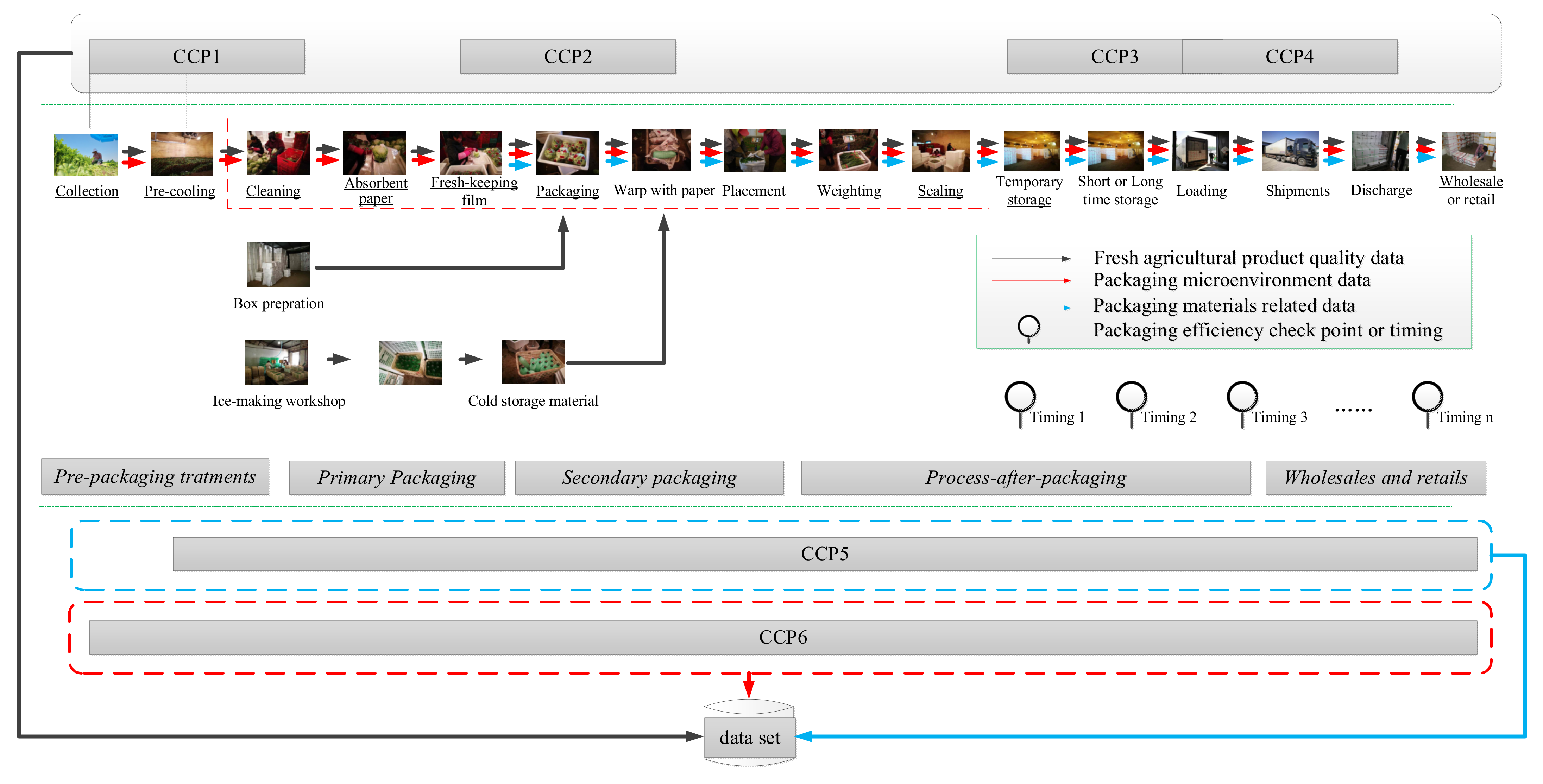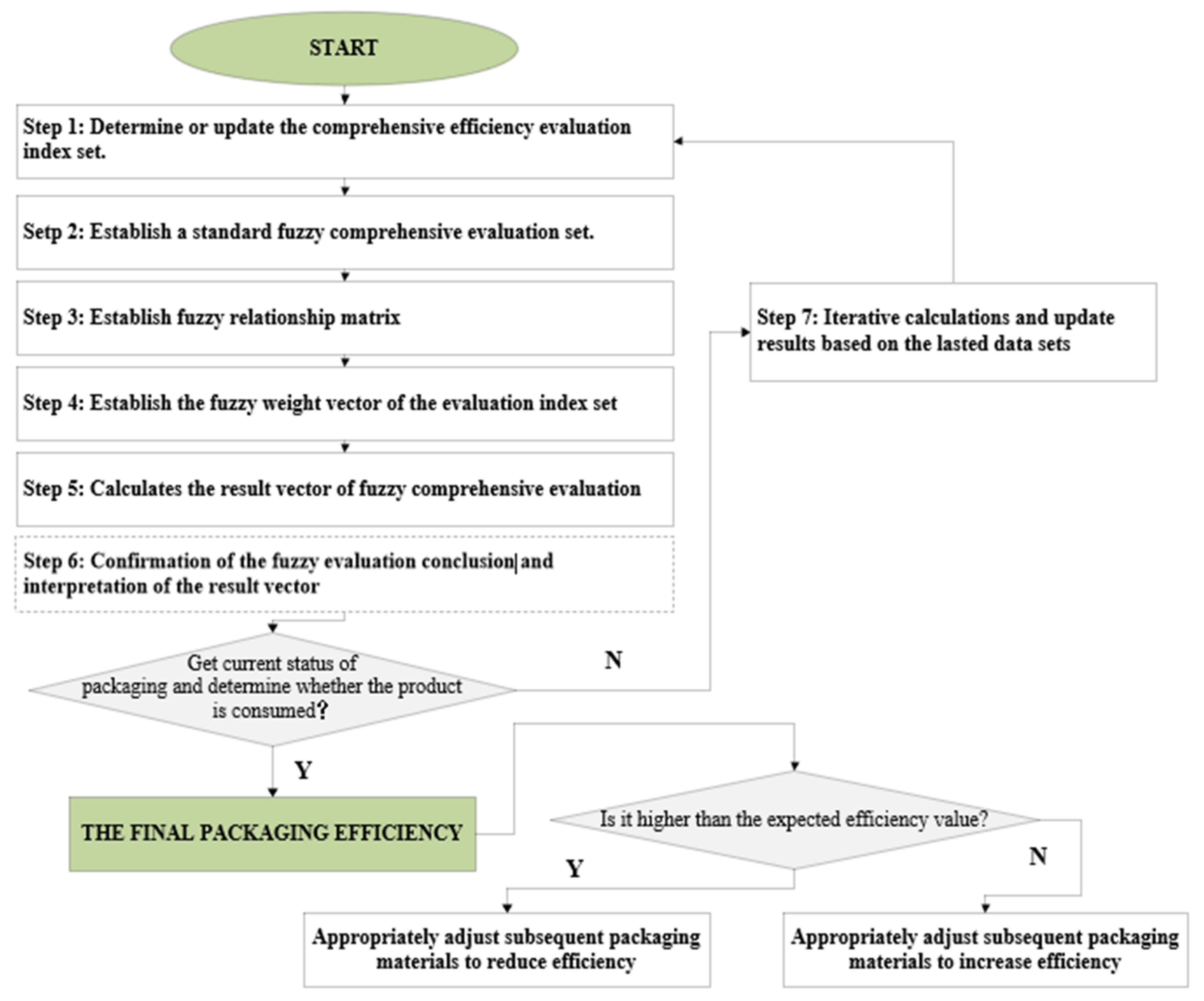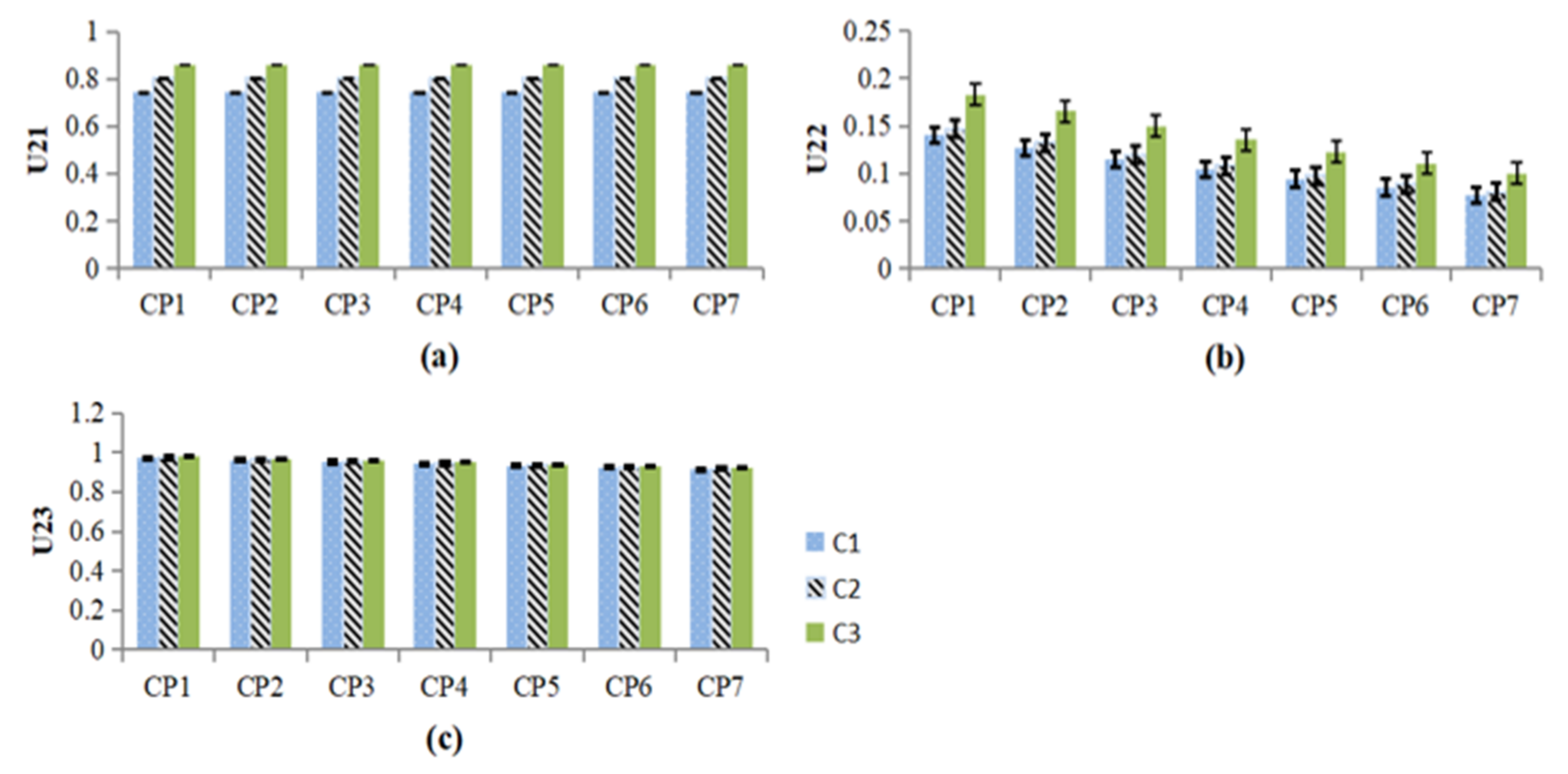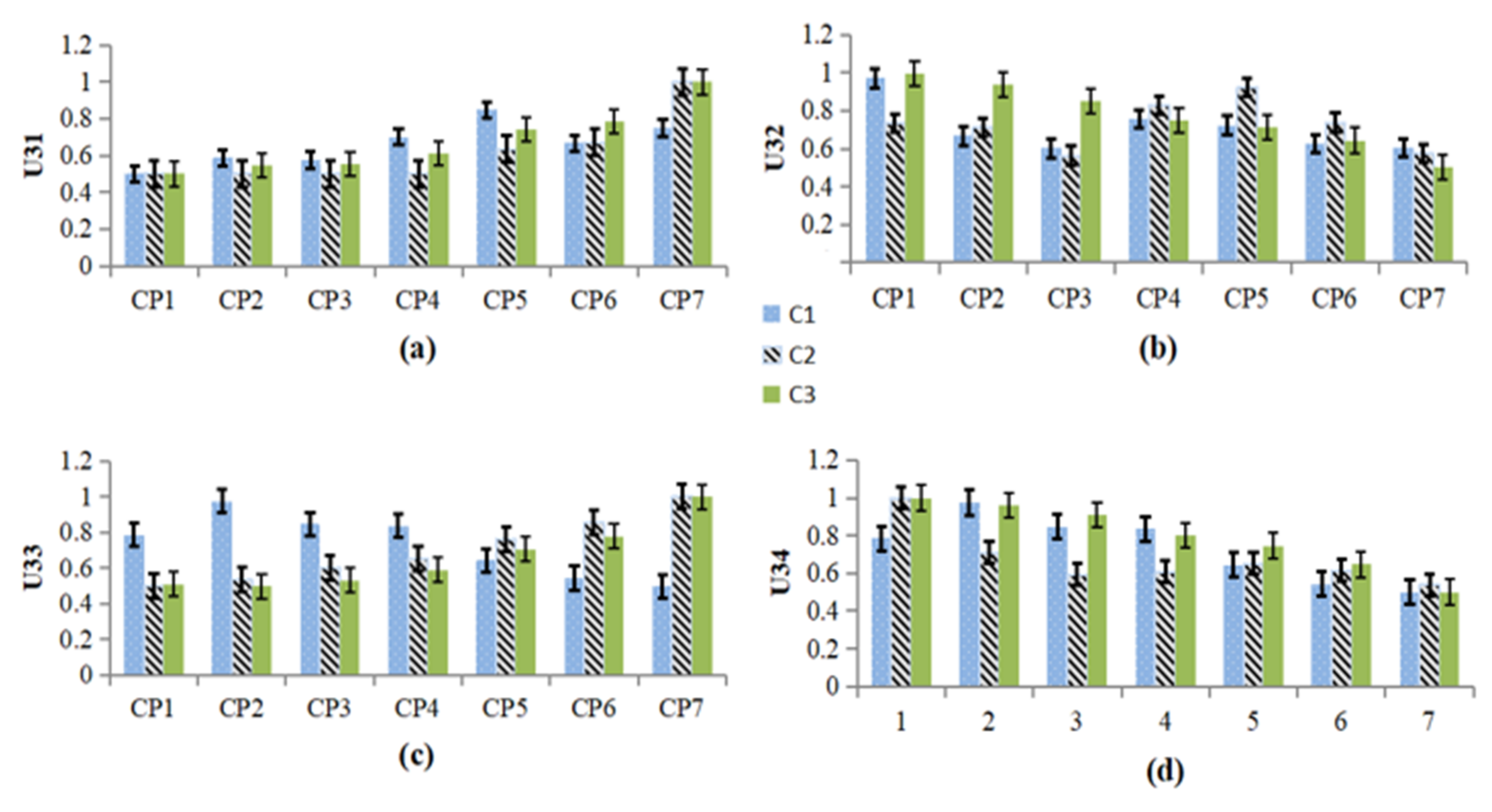A Data-Driven Packaging Efficiency Optimization Method for a Low Carbon System in Agri-Products Cold Chain
Abstract
:1. Introduction
1.1. Research Backgrounds
1.2. Literature Review
2. Materials and Methods
2.1. Concept of Data-Driven Packaging Efficiency Evaluation in Cold Chain
2.2. Data-Driven Packaging Efficiency Assessment Framework
2.3. Evaluation Methods
2.4. Experimental Scheme and Data Acquisition
3. Results and Discussion
3.1. Statistical Analysis on Key Indexes of the Packaging Efficiency
3.2. Fuzzy Comprehensive Evaluation on the Comprehensive Efficiency
3.3. Evaluation Result Analysis
3.4. Discussion
4. Conclusions
Author Contributions
Funding
Institutional Review Board Statement
Informed Consent Statement
Data Availability Statement
Acknowledgments
Conflicts of Interest
References
- Han, J.-W.; Zuo, M.; Zhu, W.-Y.; Zuo, J.-H.; Lü, E.-L.; Yang, X.-T. A comprehensive review of cold chain logistics for fresh agricultural products: Current status, challenges, and future trends. Trends Food Sci. Technol. 2021, 109, 536–551. [Google Scholar] [CrossRef]
- Hu, J.; Wang, J.; Zhu, Z.; Zhang, X. Analysis of Data Quality Evaluation and Optimization in IoT in Cold Chain. Trans. Chin. Soc. Agric. Mach. 2019, 50, 1–14. (In Chinese) [Google Scholar]
- Sundarakani, B.; Ajaykumar, A.; Gunasekaran, A. Big data driven supply chain design and applications for blockchain: An action research using case study approach. Omega 2021, 102, 102452. [Google Scholar] [CrossRef]
- Soltani Firouz, M.; Mohi-Alden, K.; Omid, M. A critical review on intelligent and active packaging in the food industry: Research and development. Food Res. Int. 2021, 141, 110113. [Google Scholar] [CrossRef]
- Kalpana, S.; Priyadarshini, S.R.; Maria Leena, M.; Moses, J.A.; Anandharamakrishnan, C. Intelligent packaging: Trends and applications in food systems. Trends Food Sci. Technol. 2019, 93, 145–157. [Google Scholar] [CrossRef]
- Vanderroost, M.; Ragaert, P.; Verwaeren, J.; De Meulenaer, B.; De Baets, B.; Devlieghere, F. The digitization of a food package’s life cycle: Existing and emerging computer systems in the logistics and post-logistics phase. Comput. Ind. 2017, 87, 15–30. [Google Scholar] [CrossRef]
- Bresolin, C.; Schneider, P.; Rego, R.; Bandarra, E. Brazilian cold chain panorama. Int. J. Refrig. Rev. Int. Du Froid 2018, 90, 145–155. [Google Scholar] [CrossRef]
- Mampholo, B.; Sivakumar, D.; Thompson, A. Maintaining overall quality of fresh traditional leafy vegetables of Southern Africa during the postharvest chain. Food Rev. Int. 2016, 32, 400–416. [Google Scholar] [CrossRef]
- Chauhan, C.; Dhir, A.; Akram, M.U.; Salo, J. Food loss and waste in food supply chains. A systematic literature review and framework development approach. J. Clean. Prod. 2021, 295, 126438. [Google Scholar] [CrossRef]
- Zhao, H.; Liu, S.; Tian, C.; Yan, G.; Wang, D. An overview of current status of cold chain in China. Int. J. Refrig. Rev. Int. Du Froid 2018, 88, 483–495. [Google Scholar] [CrossRef]
- Sun, S.; Lu, Y.; Gao, H.; Jiang, T.; Du, X.; Shen, T.; Wu, P.; Wang, Y. Impacts of food wastage on water resources and environment in China. J. Clean. Prod. 2018, 185, 732–739. [Google Scholar] [CrossRef]
- Wang, X.; Feng, H.; Chen, T.; Zhao, S.; Zhang, J.; Zhang, X. Gas sensor technologies and mathematical modelling for quality sensing in fruit and vegetable cold chains: A review. Trends Food Sci. Technol. 2021, 110, 483–492. [Google Scholar] [CrossRef]
- Ndraha, N.; Hsiao, H.-I.; Vlajic, J.; Yang, M.-F.; Lin, H.-T.V. Time-temperature abuse in the food cold chain: Review of issues, challenges, and recommendations. Food Control 2018, 89, 12–21. [Google Scholar] [CrossRef] [Green Version]
- Gil, M.; Selma, M.; Suslow, T.; Jacxsens, L.; Uyttendaele, M.; Allende, A. Pre- and Postharvest Preventive Measures and Intervention Strategies to Control Microbial Food Safety Hazards of Fresh Leafy Vegetables. Crit. Rev. Food Sci. Nutr. 2015, 55, 453–468. [Google Scholar] [CrossRef]
- Fabbri, S.; Olsen, S.; Owsianiak, M. Improving environmental performance of post-harvest supply chains of fruits and vegetables in Europe: Potential contribution from ultrasonic humidification. J. Clean. Prod. 2018, 182, 16–26. [Google Scholar] [CrossRef] [Green Version]
- Conte, A.; Cappelletti, G.M.; Nicoletti, G.M.; Russo, C.; Del Nobile, M.A. Environmental implications of food loss probability in packaging design. Food Res. Int. 2015, 78, 11–17. [Google Scholar] [CrossRef]
- Wikstrom, F.; Williams, H.; Verghese, K.; Clune, S. The influence of packaging attributes on consumer behaviour in food-packaging life cycle assessment studies—A neglected topic. J. Clean. Prod. 2014, 73, 100–108. [Google Scholar] [CrossRef]
- Gardas, B.; Raut, R.; Narkhede, B. Evaluating critical causal factors for post-harvest losses (PHL) in the fruit and vegetables supply chain in India using the DEMATEL approach. J. Clean. Prod. 2018, 199, 47–61. [Google Scholar] [CrossRef]
- Galic, K.; Scetar, M.; Kurek, M. The benefits of processing and packaging. Trends Food Sci. Technol. 2011, 22, 127–137. [Google Scholar] [CrossRef]
- Garrido, Y.; Tudela, J.; Hernandez, J.; Gil, M. Modified atmosphere generated during storage under light conditions is the main factor responsible for the quality changes of baby spinach. Postharvest Biol. Technol. 2016, 114, 45–53. [Google Scholar] [CrossRef]
- Jalali, A.; Seiiedlou, S.; Linke, M.; Mahajan, P. A comprehensive simulation program for modified atmosphere and humidity packaging (MAHP) of fresh fruits and vegetables. J. Food Eng. 2017, 206, 88–97. [Google Scholar] [CrossRef]
- Yang, D.; Li, D.; Xu, W.; Liao, R.; Shi, J.; Fu, Y.; Wang, J.; Wang, Y.; He, X. Design and application of a passive modified atmosphere packaging for maintaining the freshness of Chinese cabbage. LWT Food Sci. Technol. 2018, 94, 136–141. [Google Scholar] [CrossRef]
- Singh, S.; Gaikwad, K.; Lee, M.; Lee, Y. Temperature sensitive smart packaging for monitoring the shelf life of fresh beef. J. Food Eng. 2018, 234, 41–49. [Google Scholar] [CrossRef]
- Ghaani, M.; Cozzolino, C.A.; Castelli, G.; Farris, S. An overview of the intelligent packaging technologies in the food sector. Trends Food Sci. Technol. 2016, 51, 1–11. [Google Scholar] [CrossRef] [Green Version]
- Tsironi, T.; Giannoglou, M.; Platakou, E.; Taoukis, P. Evaluation of Time Temperature Integrators for shelf-life monitoring of frozen seafood under real cold chain conditions. Food Packag. Shelf Life 2016, 10, 46–53. [Google Scholar] [CrossRef]
- Dutra Resem Brizio, A.P.; Prentice, C. Use of smart photochromic indicator for dynamic monitoring of the shelf life of chilled chicken based products. Meat Sci. 2014, 96, 1219–1226. [Google Scholar] [CrossRef]
- Jedermann, R.; Ruiz-Garcia, L.; Lang, W. Spatial temperature profiling by semi-passive RFID loggers for perishable food transportation. Comput. Electron. Agric. 2009, 65, 145–154. [Google Scholar] [CrossRef] [Green Version]
- Vilela, C.; Kurek, M.; Hayouka, Z.; Rocker, B.; Yildirim, S.; Antunes, M.; Nilsen-Nygaard, J.; Pettersen, M.; Freire, C. A concise guide to active agents for active food packaging. Trends Food Sci. Technol. 2018, 80, 212–222. [Google Scholar] [CrossRef]
- Wang, J.; Zhu, Z.; Moga, L.M.; Hu, J.; Zhang, X. A Holistic Packaging Efficiency Evaluation Method for Loss Prevention in Fresh Vegetable cold chain. Sustainability 2019, 11, 3874. [Google Scholar] [CrossRef] [Green Version]
- Beitzen-Heineke, E.; Balta-Ozkan, N.; Reefke, H. The prospects of zero-packaging grocery stores to improve the social and environmental impacts of the food supply chain. J. Clean. Prod. 2017, 140, 1528–1541. [Google Scholar] [CrossRef] [Green Version]
- Bovi, G.; Caleb, O.; Ilte, K.; Rauh, C.; Mahajan, P. Impact of modified atmosphere and humidity packaging on the quality, off-odour development and volatiles of ‘Elsanta’ strawberries. Food Packag. Shelf Life 2018, 16, 204–210. [Google Scholar] [CrossRef] [Green Version]
- Fu, Z.; Xing, S.; Zhang, X. Development Trend of Food Quality Safety Traceability Technology. Trans. Chin. Soc. Agric. Mach. 2013, 44, 144–153. (In Chinese) [Google Scholar]
- Svanes, E.; Vold, M.; Moller, H.; Pettersen, M.; Larsen, H.; Hanssen, O. Sustainable Packaging Design: A Holistic Methodology for Packaging Design. Packag. Technol. Sci. 2010, 23, 161–175. [Google Scholar] [CrossRef]
- Gerassimidou, S.; Martin, O.V.; Chapman, S.P.; Hahladakis, J.N.; IaCOVIDou, E. Development of an integrated sustainability matrix to depict challenges and trade-offs of introducing bio-based plastics in the food packaging value chain. J. Clean. Prod. 2021, 286, 125378. [Google Scholar] [CrossRef]
- Herbon, A.; Ceder, A. Monitoring perishable inventory using quality status and predicting automatic devices under various stochastic environmental scenarios. J. Food Eng. 2018, 223, 236–247. [Google Scholar] [CrossRef]
- Belay, Z.; Caleb, O.; Opara, U. Modelling approaches for designing and evaluating the performance of modified atmosphere packaging (MAP) systems for fresh produce: A review. Food Packag. Shelf Life 2016, 10, 63–70. [Google Scholar] [CrossRef]
- Wang, X.; Matetic, M.; Zhou, H.; Zhang, X.; Jemric, T. Postharvest Quality Monitoring and Variance Analysis of Peach and Nectarine Cold Chain with Multi-Sensors Technology. Appl. Sci. 2017, 7, 133. [Google Scholar] [CrossRef] [Green Version]
- Defraeye, T.; Wu, W.; Prawiranto, K.; Fortunato, G.; Kemp, S.; Hartmann, S.; Cronje, P.; Verboven, P.; Nicolai, B. Artificial fruit for monitoring the thermal history of horticultural produce in the cold chain. J. Food Eng. 2017, 215, 51–60. [Google Scholar] [CrossRef]
- Dilkes-Hoffman, L.; Lane, J.; Grant, T.; Pratt, S.; Lant, P.; Laycock, B. Environmental impact of biodegradable food packaging when considering food waste. J. Clean. Prod. 2018, 180, 325–334. [Google Scholar] [CrossRef]
- Panseri, S.; Martino, P.; Cagnardi, P.; Celano, G.; Tedesco, D.; Castrica, M.; Balzaretti, C.; Chiesa, L. Feasibility of biodegradable based packaging used for red meat storage during shelf-life: A pilot study. Food Chem. 2018, 249, 22–29. [Google Scholar] [CrossRef]
- Herbes, C.; Beuthner, C.; Ramme, I. Consumer attitudes towards biobased packaging—A cross-cultural comparative study. J. Clean. Prod. 2018, 194, 203–218. [Google Scholar] [CrossRef]
- Geueke, B.; Groh, K.; Muncke, J. Food packaging in the circular economy: Overview of chemical safety aspects for commonly used materials. J. Clean. Prod. 2018, 193, 491–505. [Google Scholar] [CrossRef]
- Bernstad Saraiva, A.; Pacheco, E.B.A.V.; Gomes, G.M.; Visconte, L.L.Y.; Bernardo, C.A.; Simões, C.L.; Soares, A.G. Comparative lifecycle assessment of mango packaging made from a polyethylene/natural fiber-composite and from cardboard material. J. Clean. Prod. 2016, 139, 1168–1180. [Google Scholar] [CrossRef]
- Defraeye, T.; Cronje, P.; Berry, T.; Opara, U.; East, A.; Hertog, M.; Verboven, P.; Nicolai, B. Towards integrated performance evaluation of future packaging for fresh produce in the cold chain. Trends Food Sci. Technol. 2015, 44, 201–225. [Google Scholar] [CrossRef]








| No. | Primary Packaging | Key Packaging Materials | Secondary Packaging | Varieties | |
|---|---|---|---|---|---|
| C1 | Composite Sulfur-containing preservative CT2 | PE preservative film | 0.03 mm | 3# Styrofoam box | table grapes |
| C2 | MAP | preservative film a | - | 3# Styrofoam box | table grapes |
| C3 | Ordinary PVC | preservative film | - | 3# Styrofoam box | table grapes |
| Rating | U11 | U12 | U21 | U22 | U23 | U31 | U32 | U33 | U34 |
|---|---|---|---|---|---|---|---|---|---|
| I | 1 | 0.4 | 0.9 | 0.20 | 1 | 0.5 | 0.5 | 0.5 | 1 |
| II | 0.875 | 0.45 | 0.85 | 0.15 | 0.975 | 0.6 | 0.6 | 0.6 | 0.9 |
| III | 0.75 | 0.5 | 0.8 | 0.10 | 0.95 | 0.7 | 0.7 | 0.7 | 0.8 |
| IV | 0.625 | 0.55 | 0.75 | 0.05 | 0.925 | 0.8 | 0.8 | 0.8 | 0.7 |
| V | 0.5 | 0.6 | 0.7 | 0 | 0.9 | 0.9 | 0.9 | 0.9 | 0.6 |
| No. | |||||||
| C1 | I 2.3180 | II 2.0201 | II 2.6172 | II 2.6823 | IV 3.0023 | IV 3.0646 | IV 3.0825 |
| C2 | I 2.3324 | II 2.5789 | II 2.8383 | III 2.8037 | IV 2.9666 | IV 3.0082 | II 2.9294 |
| C3 | II 1.9136 | II 2.5789 | II 2.3335 | II 2.8157 | V 2.9933 | II 2.9690 | III 2.8628 |
Publisher’s Note: MDPI stays neutral with regard to jurisdictional claims in published maps and institutional affiliations. |
© 2022 by the authors. Licensee MDPI, Basel, Switzerland. This article is an open access article distributed under the terms and conditions of the Creative Commons Attribution (CC BY) license (https://creativecommons.org/licenses/by/4.0/).
Share and Cite
Wang, J.; Zhang, X.; Wang, X.; Huang, H.; Hu, J.; Lin, W. A Data-Driven Packaging Efficiency Optimization Method for a Low Carbon System in Agri-Products Cold Chain. Sustainability 2022, 14, 858. https://doi.org/10.3390/su14020858
Wang J, Zhang X, Wang X, Huang H, Hu J, Lin W. A Data-Driven Packaging Efficiency Optimization Method for a Low Carbon System in Agri-Products Cold Chain. Sustainability. 2022; 14(2):858. https://doi.org/10.3390/su14020858
Chicago/Turabian StyleWang, Jingjie, Xiaoshuan Zhang, Xiang Wang, Hongxing Huang, Jinyou Hu, and Weijun Lin. 2022. "A Data-Driven Packaging Efficiency Optimization Method for a Low Carbon System in Agri-Products Cold Chain" Sustainability 14, no. 2: 858. https://doi.org/10.3390/su14020858





